In the fast changing world of online marketing, businesses in every sector, including the transport business are shifting towards digital strategies to boost their reach and customer base. Many small businesses are now using online platforms to attract more clients and compete with larger companies. From a robust website to well-thought-out SEO strategies, small transport business can implement cost-effective methods to reach a large audience and secure a more significant market share. This article provides powerful strategies to help small transport companies attract new customers, build credibility, scale their services, and maintain a competitive edge.
Table of Contents
Building a Strong Online Presence

Building a strong online presence is crucial for any transport business in today’s digital strategy. By developing a professional website, optimizing for search engines, and utilizing social media, transport companies can effectively reach a larger audience and attract potential clients. A well-crafted online presence helps showcase services, share client testimonials, and highlight unique factors of the business, such as reliability and efficiency. Having a professional, easy-to-navigate website and a visible profile on search engines can be the difference between gaining and losing a customer. For transport businesses, an engaging online presence also supports trust, making it easier for clients to choose their services over competitors.
Website Essentials for Transport Business
A website is often the first interaction customers have with your business. For a transport business, the website should clearly list services, offer an easy booking process, and provide multiple contact options. Important pages include “About Us,” “Services,” “Pricing,” and “Contact Us,” with testimonials and a FAQ section to build trust.
Optimizing for Mobile Users
A mobile-optimized website is no longer optional. A responsive design ensures your website adjusts seamlessly across different devices, which is crucial as mobile searches continue to grow. For a transport business, this translates to a smoother booking experience, especially for users on the go.
Understanding the Importance of an Online Presence
For a small transport business, building a strong online presence is not just optional—it’s essential. A website is the cornerstone of a successful digital marketing strategy, allowing you to showcase your services, develop credibility, and compete with larger companies.
Why Transport Businesses Need a Website
A professional website can help small transport business look more legitimate and provide the first interaction potential customers have with the business. It’s also where customers can learn about your services, get in touch, and possibly even book directly. A well-designed website levels the playing field, allowing a small company to showcase its expertise just like a big brand.
Reaching a Wider Audience with a Website
A website gives small transport businesses the chance to reach a national or even international audience. With the right keywords and SEO strategies, you can connect with users outside your local area, turning your small business into a recognized name far beyond your community.
Understanding Your Target Audience
One of the most significant steps for any small transport business looking to grow is defining who their customers are and where to find them online. Here’s how understanding your audience can benefit your marketing efforts.
Importance of Defining Customer Information
Creating detailed customer information helps you understand the needs, motivations, and behaviors of your ideal customers. These customers based on demographic data and insights are essential for customizing marketing strategies. For example, if your transport business mainly serves small retail businesses, your customer could be a business owner aged 25-45 who prioritizes fast, reliable service at a competitive price. These insights guide everything from your website design to the type of content you share on social media.
Using Data to Understand Customer Preferences
Analyzing data through tools like Google Analytics, Facebook Insights, and customer feedback can reveal valuable insights about your audience’s interests, behavior, and preferences. This data provides a roadmap for creating content that connects directly to your audience, helping you understand if your customers respond better to email offers, social media posts, or video content.
Creating a Targeted Transport Business Plan
Creating a targeted business plan is essential for the success of a transport business. A well-crafted plan highlights the company’s goals, target market, competitive analysis, and operational strategy. It helps identify specific customer segments, such as freight, passenger, or logistics services, and details the best approaches for reaching and serving them effectively. Additionally, the plan includes financial projections and growth strategies, helping to secure funding and guiding decision-making. By matching resources and efforts with clear objectives, a targeted business plan provides a roadmap to profitability and sustainable growth in the transport industry.
Defining Business Objectives and Goals
Highlighting the purpose and goals of your transport business helps set a clear direction. Identify what services you want to offer, such as freight, personal transportation, or logistics solutions. For example, if your goal is to expand into specialized transport, like medical or perishable goods, clearly define these objectives in your plan.
Conducting a Market Analysis
Understanding the competitive world and customer demand is essential. Analyze the local market to identify your competitors, target customers, and what they value in a transport provider. This analysis will help you create services that meet unmet needs and stand out.
Generating Transport Business Ideas
Coming up with innovative transport business ideas can set you apart and attract more clients. These ideas should align with customer demands, industry trends, and your operational strengths.
Generating innovative ideas for a transport business can set the foundation for a unique and successful venture. Consider focusing on specific market needs or niche services, such as eco-friendly delivery, last-mile logistics, or specialized freight services like temperature-controlled shipping. With the rise of e-commerce, exploring options like on-demand delivery, ride-sharing, or partnering with local businesses for logistics solutions can also be helpful. Evaluating trends and gaps in the industry, as well as understanding customer problem areas can inspire practical and profitable ideas, enabling a transport business to stand out and respond to the changing needs of clients.
Exploring Niches within the Transport Sector
There are many untapped niches in the transport industry. For example, pet transport, eco-friendly logistics, or last-mile delivery for online retailers are areas with growth potential. By specializing in a niche, you can attract clients with specific needs and reduce competition.
Offering Value-Added Services
Adding unique services such as real-time tracking, flexible payment options, or guaranteed delivery windows can help small transport businesses stand out. Value-added services make your business more attractive to customers who are willing to pay a premium for reliability and convenience.
Building a Professional Website: A Competitive Advantage
Building a professional website offers a significant competitive advantage for any transport business. A well-designed, user-friendly website serves as a hub for potential clients to learn about the company’s services, routes, pricing, and contact information. It can also include features such as online booking, tracking, and customer support, which improve user experience and increase customer satisfaction. By showcasing the business’s reliability, expertise, and unique offerings, a professional website helps a transport company stand out in a competitive market, attract more clients, and develop credibility and trust in the industry.
Designing for User Experience
The layout and design of your website influence customer perception. Ensure a clean, professional look with easy navigation, fast load times, and mobile compatibility. Including key pages like About Us, Services, Testimonials, and Contact Us allows visitors to learn about your business and easily get in touch.
Highlight Customer Testimonials and Success Stories
Showcasing customer testimonials builds credibility and makes your business look more trustworthy. Customer stories that highlight your reliability and service quality can make a significant impression on potential clients, helping you compete with more developed companies.
Using SEO to Rank Higher in Search Results
SEO (Search Engine Optimization) is critical for small transport businesses looking to attract more clients online. With an optimized website, you can appear in search results when potential customers look for services like yours, leveling the playing field with larger companies.
Optimizing for Keywords
Choose relevant keywords like “Transport Business” or related to the transport. Integrate these keywords naturally into your website’s content, blog posts, and service pages. Additionally, using location-based keywords (e.g., “transport business in [City]”) can improve local search visibility.
Creating High-Quality, Informative Content
Publishing blog posts on topics like “How to Get Clients for Transport Business” or “Top 10 Tips for Running a Small Transport Business” can increase your website’s authority and attract more visitors. Informative content not only helps SEO. But also provides valuable insights to potential clients, encouraging them to choose your services.
Using Social Media to Attract Customers

Social media platforms offer a cost-effective way to reach a broad audience and build brand awareness. They allow small transport businesses to showcase services, connect with customers, and engage with potential clients.
Choosing the Right Platforms
Different social media platforms attract different audiences. LinkedIn is ideal for reaching business clients, while Facebook and Instagram work well for targeting consumers. Choosing the right platforms based on your target audience can improve the effectiveness of your social media efforts.
Engaging Content for Social Media
Posting engaging content, such as behind-the-scenes looks, client testimonials, and transport tips, can capture your audience’s attention. Creating posts that answer common questions or provide industry insights helps build credibility and keeps customers interested in your services.
Local SEO to Improve Visibility
Local SEO is vital for small businesses that depend on nearby customers. By optimizing your online presence for local searches, you increase the chances of appearing in searches by people looking for services in your area.
Utilizing Google My Business
Setting up a Google My Business profile ensures your business appears in Google Maps and local search results. Include essential information like your business address, hours, contact details, and service offerings. Regularly update this profile to maintain high visibility in local searches.
Encouraging and Managing Reviews
Customer reviews help build your online reputation. Encourage satisfied customers to leave reviews on Google, Yelp, or other review platforms. Addressing reviews (positive and negative) shows that you value feedback and care about your customers’ experiences, improving trustworthiness.
Content Marketing for Transport Businesses
Content marketing provides a way to attract visitors, improve SEO, and develop your business as an industry expert. For a small transport business, informative content can make a big difference in building credibility.
Creating Blog Posts and Articles
Blogging on topics relevant to your target audience helps position you as an expert. Posts such as “How to Choose a Transport Provider” or “The Benefits of Real-Time Tracking in Logistics” address common questions and concerns, attracting potential clients.
Developing Video Content
Videos are a powerful tool for engaging customers and showcasing your services. Consider creating short videos about your business, the services you offer, and tips on transportation best practices. These can be shared on social media, embedded on your website, or sent in email campaigns.
Cost-Effective Advertising Solutions
Paid advertising doesn’t have to be costly. Platforms like Google Ads and Facebook allow you to target specific demographics and regions, maximizing the impact of your advertising budget.
Using Google Ads to Target Relevant Searches
Google Ads can help you reach customers actively searching for services like yours. By targeting keywords such as “local transport business,” “reliable transport services,” or “affordable transport solutions,” you can increase your visibility to interested clients.
Facebook Ads for Local Targeting
Facebook Ads offer local targeting options that are ideal for small transport businesses. Promote posts highlighting special offers, seasonal discounts, or new services to attract local customers. With precise targeting, you can reach users near your business, increasing the chances of conversion.

Email Marketing for Customer Retention
Email marketing allows you to stay connected with past clients, providing updates, offers, and industry insights. Regular communication increases brand recall, making it more likely that previous clients will choose your business for their next transportation needs.
Building a Targeted Email List
Encourage website visitors to sign up for updates by offering something valuable, like a free consultation or a discount on the first booking. With a well-segmented email list, you can reach specific customer groups with customized messages, improving retention rates.
Sending Valuable, Relevant Content
Email newsletters should provide useful information, exclusive offers, or announcements of new services. Avoid excessive promotional content, focusing instead on information that can help clients make informed decisions about their transportation needs.
Collaborating with Other Local Businesses
Partnering with local businesses can broaden your reach and create a strong referral network. Collaborations introduce your transport business to new customer bases without high marketing costs.
Building Strategic Partnerships
Find businesses that share your target audience but aren’t in direct competition. For example, if your transport business offers courier services, collaborating with local retail stores can be mutually beneficial. You can refer customers to each other, expanding your client base.
Co-marketing Opportunities
Consider co-marketing initiatives, such as hosting an event together or creating a shared promotional campaign. These collaborations can be cost-effective and help you reach a larger audience.
Tracking and Measuring Success
To make the most of these strategies, monitor your progress and adjust as needed. Tracking tools like Google Analytics can provide insights into website traffic, while social media analytics help you understand engagement levels.
Using Analytics to Guide Future Strategies
Analyzing metrics such as website visitors, conversion rates, and social media engagement shows what’s working and where improvements are needed. This data can help you refine your approach, focusing on the strategies that produce the best results.
Adjusting Based on Performance
Digital marketing strategies require flexibility. Regularly reviewing your results allows you to make data-driven decisions, shifting your focus to areas that generate the most leads and customers.
FAQs
1- How can a small transport business attract more clients online?
Using strategies like a professional website, SEO, social media, and content marketing helps increase visibility and attract potential clients.
2- What should be included in a transport business plan?
A transport business plan should cover your services, target market, competitive analysis, and a strategy for reaching new customers.
3- How can local SEO help a small transport business?
Local SEO helps businesses appear in searches by nearby customers looking for services, improving visibility and bringing in local clients.
4- What are some transport business ideas to explore?
Specialized services like eco-friendly transport, pet transport, or medical transport offer unique value and can attract niche markets.
5- How does content marketing benefit a small transport business?
Content marketing builds credibility and improves SEO, helping attract website visitors and developing your business as an industry leader.
Conclusion
The marketing world for a transport business in 2025 is full of potential for growth, even on a limited budget. Small transport businesses can use cost-effective digital strategies to reach a wider audience, attract new clients, and stand out against larger competitors. From a professional website to focusing on building an online presence, using social media, using local SEO, and tracking performance, these tactics empower small businesses to compete in a rapidly changing industry. By implementing the strategies highlighted above, transport business owners can drive growth and build a loyal customer base.
If you enjoyed this article about the transport business, share your thoughts in the comments below! Please visit www.uniqueincs.com for more valuable content and claim your free e-book. Plus, explore discounted Digital Marketing Products to boost your business!
Improve your digital presence with an innovative website design that seamlessly integrates style and utility. Connect with www.uniquewebonline.com, using the most current trends and technologies to create visually pleasing and user-centric websites customized to increase your brand. Always prepared to captivate your audience and make a lasting impression, Unique Web Online invites you to create a digital experience that distinguishes you. Explore our portfolio and get started on the path to a striking, responsive, and effective website today.

